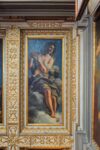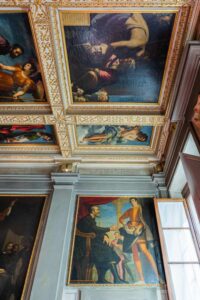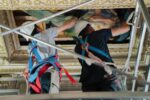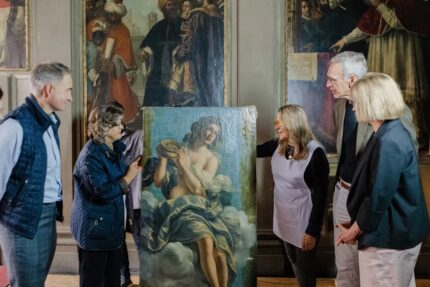 A nude by Artemisia Gentileschi that was censored with extraneous draping is being restored in public at the Casa Buonarroti museum in Florence. The painting of a young woman holding a basin of water containing a compass with a small bright star above her head is the Allegory of Inclination (ie, natural talent for art). When she was painted in 1616, Inclination was nude, but 65 years later a draped cloth was painted over her lap for “modesty.” It is now fully ensconced in the painting’s history and will not be removed, but conservators will use the latest imaging techniques to digitally remove the drapery and reveal Artemisia’s original vision.
A nude by Artemisia Gentileschi that was censored with extraneous draping is being restored in public at the Casa Buonarroti museum in Florence. The painting of a young woman holding a basin of water containing a compass with a small bright star above her head is the Allegory of Inclination (ie, natural talent for art). When she was painted in 1616, Inclination was nude, but 65 years later a draped cloth was painted over her lap for “modesty.” It is now fully ensconced in the painting’s history and will not be removed, but conservators will use the latest imaging techniques to digitally remove the drapery and reveal Artemisia’s original vision.
Casa Buonarroti was bought by the great Renaissance master Michelangelo in 1508. It was not his primary residence, but he lived there for some time when he was in Florence. He let his nephew Leonardo move in around 1540. He lived there, later with his wife and children, until his death in 1599. Leonardo’s third son was born in that house in 1568, four years after Michelangelo’s death. He was dubbed Michelangelo the Younger after his illustrious great-uncle.
 After his father’s death, the Younger undertook extensive renovations on the old family home, enlarging it and hiring the premier artists of the time to adorn it. For the home’s long gallery, he had the coffers in the ceiling painted with different scenes from the life and artistry of Michelangelo the Elder. Artemisia Gentileschi was one of the artists chosen. She was making a splash on the artistic scene in Florence, and Michelangelo the Younger played a big role in that. He was a personal friend of the family, and had in fact happened to be visiting Rome when Artemisia was born and was present for her birth. He considered her a great talent and like a daughter to him. He helped launch her career in Florence after she left Rome, introducing her to high-powered, deep-pocketed members of Florence’s art-buying elite, commissioning work and promoting her talent at the Medici court. For the Allegory, he payed her more than three times what he paid the other artists who painted the coffers in the gallery.
After his father’s death, the Younger undertook extensive renovations on the old family home, enlarging it and hiring the premier artists of the time to adorn it. For the home’s long gallery, he had the coffers in the ceiling painted with different scenes from the life and artistry of Michelangelo the Elder. Artemisia Gentileschi was one of the artists chosen. She was making a splash on the artistic scene in Florence, and Michelangelo the Younger played a big role in that. He was a personal friend of the family, and had in fact happened to be visiting Rome when Artemisia was born and was present for her birth. He considered her a great talent and like a daughter to him. He helped launch her career in Florence after she left Rome, introducing her to high-powered, deep-pocketed members of Florence’s art-buying elite, commissioning work and promoting her talent at the Medici court. For the Allegory, he payed her more than three times what he paid the other artists who painted the coffers in the gallery.
Michelangelo the Younger’s nephew Lionardo inherited the family home. In the early 1680s, he commissioned the artist Baldassarre Franceschini, aka Volterrano, to drape a lap blanket and a veil over Artemisia’s Allegory. Lionardo was concerned about that the naked lady on the ceiling was indecorous for in his home where his wife and “a crowd of young boys” lived. That deed was done with the painting in situ, so the Allegory has not been removed from the ceiling since its creation until now.
 Restorers took the painting down and installed it in one of the museum’s halls where it will be studied and conserved in public view from October 2022 to April 2023. Every Friday, conservators at work will answer questions from the public. A companion exhibition at Casa Buonarroti will run from September 2023 to January 2024.
Restorers took the painting down and installed it in one of the museum’s halls where it will be studied and conserved in public view from October 2022 to April 2023. Every Friday, conservators at work will answer questions from the public. A companion exhibition at Casa Buonarroti will run from September 2023 to January 2024.
“Through working photographs, diagnostic imaging and analysis, we will be able to determine the exact technique Artemisia used, correctly map the work’s condition, and monitor our treatment plan for the painting,” says US Florence-based conservator Elizabeth Wicks, who heads the project’s state-of-the art team comprising expert technicians and restoration scientists, under the supervision of Casa Buonarroti Director Alessandro Cecchi and Jennifer Celani, official for the Archaeological Superintendence for the Fine Arts and Landscape for the metropolitan city of Florence. “Due to the historic nature of the repaints, it is not possible to remove them from the surface, but the scope of our diagnostics will facilitate the creation of a virtual image of the original that lies beneath the surface of the painting, as we see it today,” Wicks explains. “Next week, we start our virtual journey ‘beneath the veil’ under diffuse and raking light sources, followed by UV and infrared research. Hypercolormetric Multispectral Imaging and examination by digital microscope will then help us learn as much as possible about the condition of the original painting technique and the later repaints. X-ray and high-resolution reflectography and other analytical techniques will follow.”
